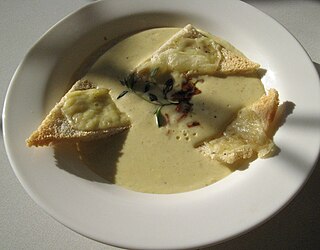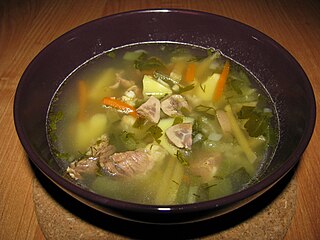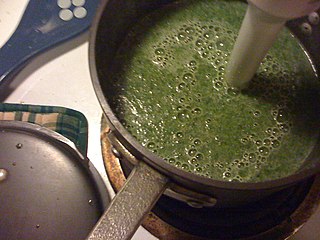
Vegetable soup is a common soup prepared using vegetables and leaf vegetables as primary ingredients. It dates to ancient history, and is a mass-produced food product in contemporary times.

Vegetable soup is a common soup prepared using vegetables and leaf vegetables as primary ingredients. It dates to ancient history, and is a mass-produced food product in contemporary times.


Vegetable soup is prepared using vegetables, leafy greens, mushrooms, and roots as the main ingredients. Some fruits, such as tomato and squash, are considered vegetables in such a context. [1] Vegetable soup can be prepared as a stock- or cream-based soup. [2] [3] Basic ingredients in addition to vegetables can include beans and legumes, grains, tofu, noodles and pasta, vegetable broth or stock, milk, cream, water, olive or vegetable oil, seasonings, salt and pepper, among myriad others. [4] [5] [6] [7] Some vegetable soups are pureed and run through a sieve, straining them to create a smooth texture. [8] It is typically served hot, although some, such as gazpacho, are typically served cold. [9] Vegetable soup is sometimes served as a starter or appetizer dish. [10]
Vegetable soup is mass-produced in canned, frozen, dried, powdered, and instant varieties. [11] [12] [13] [14]
Vegetable soup dates to ancient history. A 5th-century Roman cookbook included a recipe for "a forerunner of onion soup." [15] Broth is mentioned by approximately the year 1000 and potage by the 1400s. [16] Clifford Wright has stated that cabbage soup was important in medieval Italian cuisine. [17]
In central Appalachia, vegetable soup, also referred to as winter vegetable soup and country soup, is a traditional staple food and common dish during the months of December–February among Appalachian highlanders. [18]

Minestrone is a thick soup of Italian origin made with vegetables, often with the addition of pasta or rice, sometimes both. Common ingredients include beans, onions, celery, carrots, leaf vegetables, stock, parmesan cheese and tomatoes.

Chowder is a thick soup prepared with milk or cream, a roux, and seafood or vegetables. Oyster crackers or saltines may accompany chowders as a side item, and cracker pieces may be dropped atop the dish. New England clam chowder is typically made with chopped clams and diced potatoes, in a mixed cream and milk base, often with a small amount of butter. Other common chowders include seafood chowder, which often consists of fish, clams, and other types of shellfish; lamb or veal chowder made with barley; corn chowder, which uses corn instead of clams; various fish chowders; and potato chowder, which is often made with cheese. Fish, corn, and clam chowders are popular in North America, especially New England and Atlantic Canada.

Mashed potato or mashed potatoes, colloquially known as mash, is a dish made by mashing boiled or steamed potatoes, usually with added milk, butter, salt and pepper. It is generally served as a side dish to meat or vegetables. Roughly mashed potatoes are sometimes called smashed potatoes. Dehydrated instant mashed potatoes and frozen mashed potatoes are available. Mashed potatoes are an ingredient in other dishes, such as dumplings and gnocchi.

Russian cuisine is a collection of the different dishes and cooking traditions of the Russian people as well as a list of culinary products popular in Russia, with most names being known since pre-Soviet times, coming from all kinds of social circles.

Jewish cuisine refers to the worldwide cooking traditions of the Jewish people. During its evolution over the course of many centuries, it has been shaped by Jewish dietary laws (kashrut), Jewish festivals and holidays, and traditions centred around Shabbat. Jewish cuisine is influenced by the economics, agriculture, and culinary traditions of the many countries where Jewish communities have settled and varies widely throughout the entire world.

Corn chowder is a chowder soup prepared using corn as a primary ingredient. Basic corn chowder is commonly made of corn, onion, celery, milk or cream, and butter. Additional ingredients sometimes used include potatoes or squash, salt pork, fish, seafood and chicken. In the United States, recipes for corn chowder date to at least as early as 1884. Corn chowder is mass-produced as a canned food in the U.S.

Soup is a primarily liquid food, generally served warm or hot, that is made by combining ingredients of meat or vegetables with stock, milk, or water. Hot soups are additionally characterized by boiling solid ingredients in liquids in a pot until the flavors are extracted, forming a broth. Soups are similar to stews, and in some cases there may not be a clear distinction between the two; however, soups generally have more liquid (broth) than stews.

Cheese soup is a type of soup prepared using cheese as a primary ingredient, along with milk, broth and/or stock to form its basis. Various additional ingredients are used in its preparation, and various types and styles of cheese soup exist. It is a part of some cuisines in the world, such as American, Colombian, Mexican, Swiss, French, and Tibetan cuisines. Mass-produced cheese soups may be prepared with the addition of food additives to preserve them and enhance flavor. A list of cheese soups is included in this article.

Bean dip is a type of dipping sauce made using beans or refried beans as a primary ingredient. It is typically served with tortilla chips, and can also be served with other foods such as crackers and crudités. Various types of beans are used, and fresh-cooked, canned or flaked beans can be used. Various additional ingredients are used in its preparation, such as onion, garlic, chili peppers and spices, and it is sometimes garnished with some ingredients. Bean dip can be served cold, at room temperature, or hot. Bean dip is sometimes used as an ingredient in the preparation of other dishes such as burritos and quesadillas.

Pickle soup is a style of soup prepared with various types of pickled vegetables. Dill pickle soup is a variety of pickle soup prepared with pickled cucumber. Some versions use grated dill pickle in their preparation. Some restaurants in the United States offer the dish to their patrons, such as Polish grocery stores and restaurants in Chicago's south side.

Cream of broccoli soup is a soup prepared with broccoli, stock, and milk or cream as primary ingredients. Ingredient variations exist, as do vegan versions. It is also a commercially, mass-produced soup, often sold in cans. Several recipes use canned cream of broccoli soup as an ingredient, such as its use with cooked chicken dishes and as a sauce.

Acquacotta is a hot broth-based bread soup in Italian cuisine that was originally a peasant food. Its preparation and consumption dates back to ancient history, and it originated in the coastal area known as the Maremma in southern Tuscany and northern Lazio. The dish was invented in part as a means to make hardened, stale bread edible. In contemporary times, ingredients can vary, and additional ingredients are sometimes used. Variations of the dish include aquacotta con funghi and aquacotta con peperoni.

Carrot soup is a soup prepared with carrot as a primary ingredient. It can be prepared as a cream- or broth-style soup. Additional vegetables, root vegetables and various other ingredients can be used in its preparation. It may be served hot or cold, and several recipes exist.

Spinach soup is a soup prepared using spinach as a primary ingredient. A common dish around the world, the soup can be prepared as a broth-based or cream-based soup, and the latter can be referred to as "cream of spinach soup." In China, a spinach and tofu soup is also known as "emerald and white jade soup"; spinach and tofu represent emerald and white jade respectively, and thus the spinach soup itself can be called "emerald soup". Fresh, canned or frozen spinach can be used, and the spinach can be used whole, puréed or chopped. Additional ingredients can include onion, green onion, carrot, celery, tomatoes, potatoes, lemon juice, olive oil, seasonings, salt and pepper. Spinach soup is typically served hot, but can also be served as a cold soup. Prior to being served, it can be topped or garnished with ingredients such as sour cream and crème fraîche.

Avocado soup is a fruit soup prepared using avocados as a primary ingredient. Ingredients used in its preparation in addition to ripe avocados can include milk, cream, half-and-half or buttermilk, soup stock or broth, water, lime juice, lemon juice, salt and pepper. Additional ingredients used can include onions, shallots, garlic, hot sauce, cilantro, red pepper, cayenne pepper and cumin, and water can be used to thin the soup. It is enjoyed widely in areas of Mexico as a classic dish.
{{cite journal}}: Cite journal requires |journal= (help)